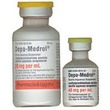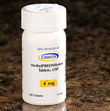Pronunciation
METH-il-pred-NIS-oh-lone - Pronunciation guide
Brand Names
- Depo-Medrol
- Medrol
- Solu-Medrol
Description
 Methylprednisolone is a synthesized adrenal steroid. It is a 6-methyl derivative of prednisolone and exceeds prenisolone in anti-inflammatory potency. It offers an advantage over older corticosteroids with the use of lower doses.
Methylprednisolone is a synthesized adrenal steroid. It is a 6-methyl derivative of prednisolone and exceeds prenisolone in anti-inflammatory potency. It offers an advantage over older corticosteroids with the use of lower doses.
Methylprednisolone is available in several formulas including methylprednisolone sodium succinate and methylprednisolone acetate.
Usage
Methylprednisolone is given systemically to decrease inflammatory and immune responses in horses. It may also be injected into joints to decrease local inflammation by stabilizing cell membranes, altering white blood cells, and influencing chemical responses to inflammation including reduction of prostaglandin production.
Methylprednisolone is also used systemically in high doses in emergencies for anaphylactic reactions, spinal cord trauma, or shock.
In addition, it is used in lower doses to treat allergic reactions such as hives, itching, heaves and arthritis, and may be used topically to treat certain conditions of the skin and eyes.
Dosage and Administration
 Methylprednisolone Methylprednisolone |
||||
|---|---|---|---|---|
| Method | Dosage (click row for calculator) |
Concentration | Period | Duration |
| As an anti-inflammatory | ||||
| Intramuscular injection (methylprednisolone acetate) | 200 mg | 20 mg/ml | Daily | NA |
| Intramuscular injection (methylprednisolone acetate) | 200 mg | 40 mg/ml | Daily | NA |
| For intrasynovial use | ||||
| Intrasynovial injection (methylprednisolone acetate) | 40-240 mg 1 | 20 mg/ml | Treatment | NA |
| Intrasynovial injection (methylprednisolone acetate) | 40-240 mg 1 | 40 mg/ml | Treatment | NA |
| For accute spinal cord injury | ||||
| Intravenous injection (methylprednisolone sodium succinate) | 2-4 mg/kg | Various | Daily | NA |
| For shock (Robinson 1987) | ||||
| Intravenous injection (methylprednisolone sodium succinate) | 10-20 mg/kg | Various | Treatment | NA |
Notes:
|
||||
Side Effects
Systemic corticosteroids can mask signs of infection and suppress the immune response. Horses receiving systemic corticosteroids may be more susceptible to bacterial or viral infections.
While concerns have been raised about possible links between corticosteroid use and laminitis, current data establishing a direct correlation is lacking.
Increased urination, increased water consumption, and muscle wasting can occur with prolonged corticosteroid use.
Corticosteroids can cause or worsen gastric ulcers.
Precautions
When treatment is to be withdrawn after prolonged use, the dose should be reduced gradually to prevent the symptoms of corticosteroid insufficiency and reduce the risk of a flare-up of the disease being treated.
Before injection into any joint, an appropriate clinical work up including radiographs should be done.
Corticosteroids should be avoided in young foals and during pregnancy and lactation unless the benefits outweigh the risks.
Methylprednisolone is FDA approved for use in horses and is a prescription drug restricted to use by or on the lawful written or oral order of a licensed veterinarian.
Some corticosteroids are commonly used in competition horses, but are forbidden in any drug-free competition. It is important to check with the individual regulatory group regarding use in competition horses.
Interactions
Corticosteroids increase risk of electrolyte imbalances due to calcium and potassium losses when diuretics such as furosemide are given.
The risk of gastrointestinal ulcers may be increased if corticosteroids and NSAIDs are given at the same time.
Corticosteroids should not be given intravenously with fluids containing calcium.
Overdose
Immediately call your veterinarian. Read and follow manufacturer's directions carefully.
Images
 DepoMedrol Injection
DepoMedrol Injection
 MethylPREDNISolone Tablets
MethylPREDNISolone Tablets
Literature
